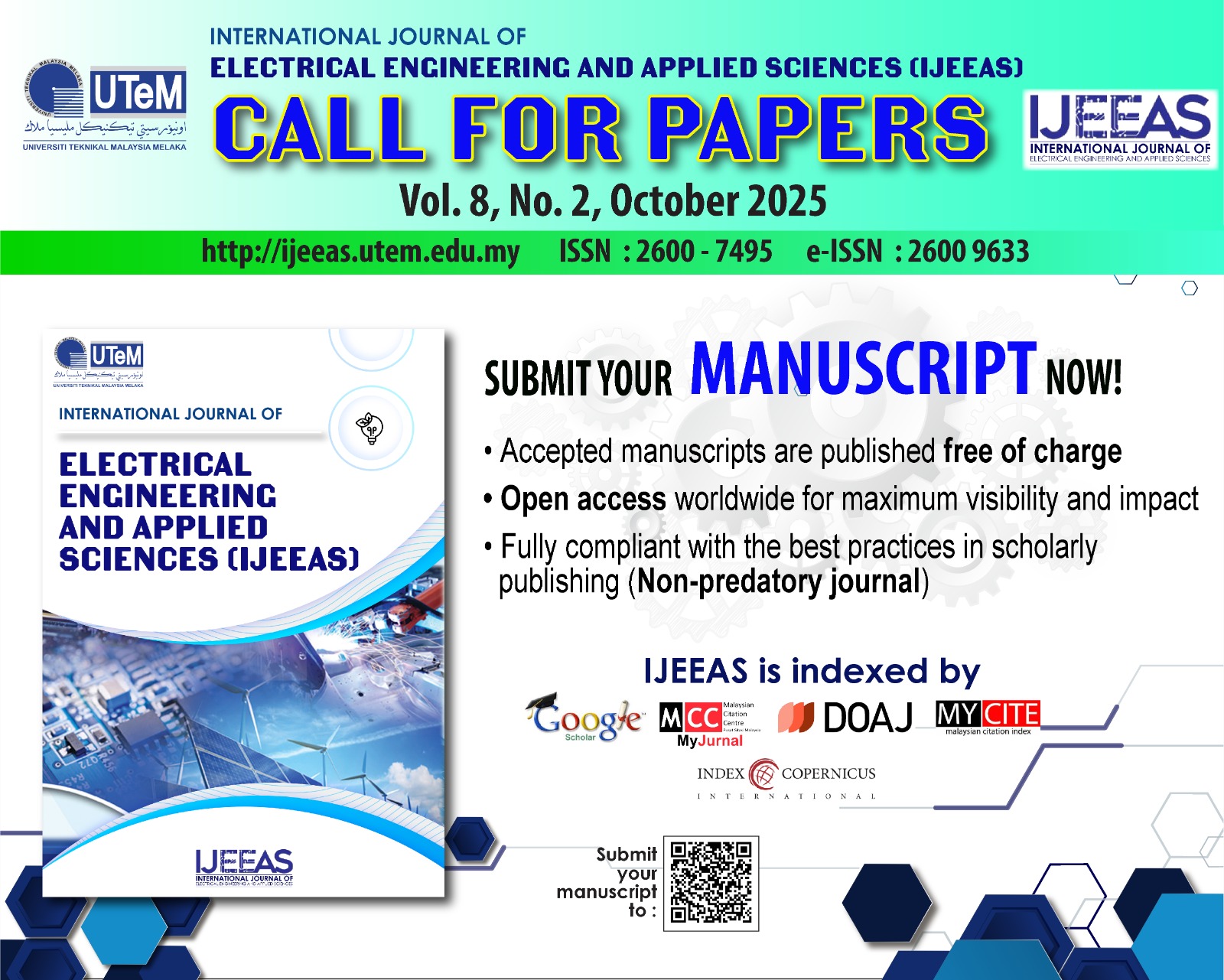Evaluation of Parameters in the Development of a Building Protection System
Keywords:
lightning rod, protection needs, strike radiusAbstract
This research aims to determine the external lightning protection system that has been installed as well as determine the effectiveness of the lightning protection system. The method is carried out by observation, measurement of building protection needs from lightning strikes, protection radius, conductor distribution, and ground termination. Based on the evaluation results, there is a radius of 150 m that has been previously designed to protect buildings that are scattered with high termination air of 30 m from the ground. The measurement results of 1.55 Ω of earth resistance was obtained after adding 3 copper conductors with a diameter of ¾ inch with a length of 2 m.
Downloads
References
Russell, Katie W., Cochran, Amalia L., Mehta, Sagar T.
Morris, Stephen E., McDevitt, Marion C. Lightning Burns, Journal of Burn Care & Research. 2014; 35 (6): e436-e438. http://dx.doi.org/10.1097/BCR.0b013e3182957783
Cooray, Vernon. Basic Principles of Lightning Protection. In: An Introduction to Lightning. Springer, Dordrecht. 2015.
http://dx.doi.org/10.101 07 / 978-94-017-8938-7 17
Suryadi, Aris. 2017. Design of the Franklin Method External Lightning Protection Installation at the Indorama Engineering Polytechnic, SINERGI Vol. 21, No. 3, October 2017: 219-230. http://doaj.org/toc/2460-1217
http://doi.org/10.22441/sinergi.2017.3.009
Gagné, M artin., Daniel Therriault, Lightning strike protection of composites, Progress in Aerospace Sciences, 2014; 64: 1-16.
http://dx.doi.org/10.1016/j.paerosci.2013.07.002
Du, Y., Binghao Li, Mingli Chen, Surges induced in building electrical systems during a lightning strike, Electric Power Systems Research, 2016; 139: 68-74. http://dx.doi.org/10.1016/j.epsr.2015.11.034
Johns, David., Designing building structures for protection against EMP and lightning, IEEE Electromagnetic Compatibility Magazine. 2016; 5 (1): 50-58.
http://dx.doi.org/10.1109/MEMC.2016.7477134
Hosea, Emmy., Iskanto, Edy and M. Harnyatris Luden., The Application of the Netting Method, Protection Angle and Rolling Ball in the External Lightning Protection System Applied to the W Building of Petra Christian University. Journal of Electrical Engineering , 2004 ; : 4 (1): 1-9.
Tabrani, Aan. Lightning Protection System at PT. Bhakti Wasantara Net Jakarta. Final Project S1, Mercu Buana University. Jakarta. 2009
Ugahari, Yudi and Garniwa, Iwa. External Lightning Protection Protection Analysis using Collection Volume Method. Journal of Electrical Engineering UI. 2007. "
SNI 03-7015-2004. Lightning Protection Systems in Buildings. National Standardization Agency. 2004.
Hutauruk. Neutral Powering of Power Systems and Gearing of Equipment. Jakarta: Erlangga, 1991.
NFPA 780: Standard for the Installation of Lightning Protection Systems. 2004 Edition.
Golde, RH Lightning. Volume 2. London: Academic Press Inc.1981.
Hasse, Peter. Overvoltage Protection of Low Voltage System. London: Peter Peregrimus Ltd.1987.
IEC 1024-1-1: Protection of StructuresAgainst Lightning.
International Electrotechnical Commission 81, 1993.
IEC, Assement of The Risk of Damage Due to Lightning, International Standards , CEI IEC 1662 First Edition, 1995.
General Rules for Lightning Protection Installations for Buildings in Indonesia. Directorate of building matter investigation. Jakarta, 1983.
Petrov NI, Alessandro FD Lightning to earthed structure: comparison of models with lightning strike data . 1996.
Downloads
Published
How to Cite
Issue
Section
License
Authors who publish with this journal agree to the following terms:
- Authors retain copyright and grant the journal right of first publication with the work simultaneously licensed under a Creative Commons Attribution License that allows others to share the work with an acknowledgement of the work's authorship and initial publication in this journal.
- Authors are able to enter into separate, additional contractual arrangements for the non-exclusive distribution of the journal's published version of the work (e.g., post it to an institutional repository or publish it in a book), with an acknowledgement of its initial publication in this journal.
- Authors are permitted and encouraged to post their work online (e.g., in institutional repositories or on their website) prior to and during the submission process, as it can lead to productive exchanges, as well as earlier and greater citation of published work (See The Effect of Open Access).







